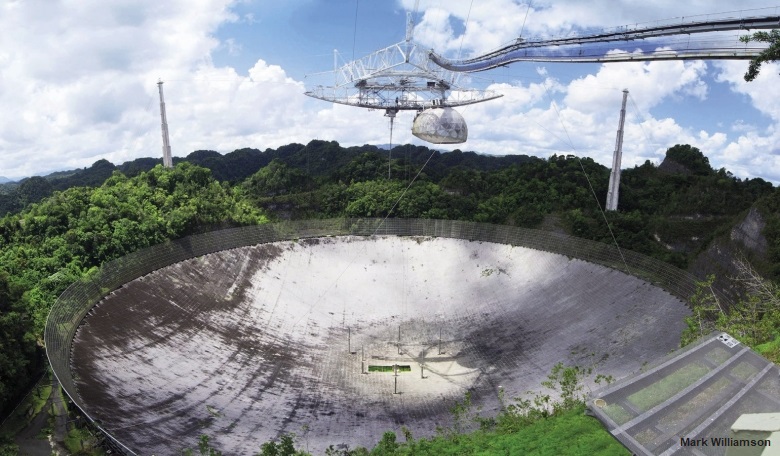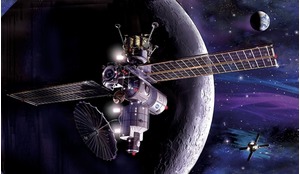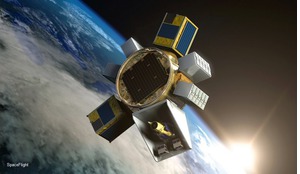To the general public, Arecibo Observatory in Puerto Rico is known for activities as diverse as the search for extra-terrestrial intelligence (SETI) and providing a set for films such as Carl Sagan’s Contact and the James Bond thriller Goldeneye. However, the historic observatory is mainly celebrated for its outstanding scientific legacy in radio and radar astronomy, as former deputy director Joan Schmelz explains.
Although the original inspiration for the giant telescope at the Arecibo Observatory was to study the ionosphere, it was obvious from the beginning that radio and radar astronomy would be an important part of its scientific mission. The site was selected not only for the natural sinkhole that would support the 305 m dish, but also so the ecliptic and Milky Way would pass overhead. Construction began in 1960 and the official commissioning took place on 1 November 1963.
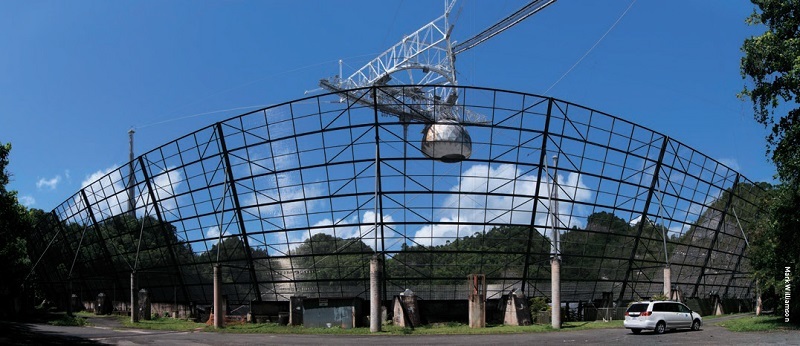 The 16 m tall ‘ground screen’ that surrounds the Arecibo telescope to limit thermal noise from local vegetation and the ground surrounding the telescope.
The 16 m tall ‘ground screen’ that surrounds the Arecibo telescope to limit thermal noise from local vegetation and the ground surrounding the telescope.
Fundamental radio and radar discoveries from the early years included the rotation rate of the planet Mercury and the period of the Crab pulsar, a rotating neutron star. Before Arecibo, Mercury was thought to be tidally locked to the Sun, with orbital and rotational periods of 88 days. However, in 1965, Arecibo radar observations showed that this was not true: the actual rotational period is 59 days, an orbital resonance, where the planet orbits twice for every three rotations. In 1968, Arecibo found that sporadic radio pulses from the direction of the Crab Nebula supernova remnant were generated by a pulsar with a period of just 33 milliseconds. This was the first in a long line of pulsar discoveries made at Arecibo.
Upgrades
Fundamental radio and radar discoveries from the early years included the rotation rate of the planet Mercury and the period of the Crab pulsar
In 1974, the Arecibo telescope received its first significant upgrade. The wire-mesh surface of the 20-acre dish was replaced with a set of around 40,000 perforated aluminium panels. This resulted in a new, high-precision surface with a root-mean-square accuracy (RMS) of less than 3 mm, allowing a frequency response as high as 2 GHz. This meant that the 21 cm line of neutral hydrogen, which dominates the interstellar medium of the Milky Way as well as distant galaxies, could now be observed at Arecibo. The upgrade also included the addition of the S-band (2380 MHz/13 cm) transmitter to improve radar studies of planetary surfaces.
The upgrades were still in progress when Arecibo’s next great discovery took place. This involved the discovery of the first pulsar in a binary system, which led to an important confirmation of Einstein’s theory of general relativity. The 1993 Nobel Prize in Physics was awarded to astronomers Russell Hulse and Joseph Taylor for “the discovery of a new type of pulsar, a discovery that has opened up new possibilities for the study of gravitation”. Indeed, the changes observed in the periastron of the binary system – the point of closest approach - led to the first indirect evidence of gravitational waves.
The first radar ranging of an Earth-crossing asteroid, 1862 Apollo, was done in 1980 and, a year later, the first radar maps of the geological surface of Venus were produced. Optical observations of Venus see only the cloud tops, but radar can penetrate the clouds and reveal surface details.
Nineteen-eighty-two marked the discovery of the first OH Megamaser, Arp 220, the nearest ultra-luminous infrared galaxy, which has merged with another galaxy and is undergoing a burst of star formation. A maser is analogous to a laser – an acronym for light amplification by stimulated emission of radiation – with the light ‘replaced’ by radiation at microwave frequencies. The population inversion of atoms required for maser emission is produced in Arp 220 by infrared radiation from interstellar dust heated by newborn stars.
The first millisecond pulsar, PSR 1937+21, was also discovered in 1982. It has a pulse period of 1.6 milliseconds, meaning that the neutron star is rotating 640 times each second. This established the existence of a second class of pulsars and required new modelling to explain the ultra-fast rotation.
In 2001, the Arecibo telescope celebrated the new century by gaining recognition as an IEEE Electrical Engineering Milestone and an ISME Mechanical Engineering Landmark
Then, in 1992, ice was detected in the shadowed craters at Mercury’s north and south poles. It persists despite temperatures as high as 425C at the planet’s surface. The discovery of the first exoplanet was also made in 1992; it was part of a planetary system of at least three Earth-like planets around the millisecond pulsar PSR 1257+12.
1997 marked a second major upgrade for Arecibo when the Gregorian dual-reflector feed was installed. This replaced the line feed, which collected radiation along an axis, with a Gregorian reflector which effectively transformed the spherical dish into a paraboloid that works at all frequencies. The S-band transmitter was also upgraded to a one megawatt system. The following year, NASA and ESA lost contact with the SOHO satellite, the solar and heliospheric observatory, and the new radar at Arecibo was able to find it by bouncing a signal off it. This was the first step in re-establishing contact and SOHO was later able to resume scientific operations.
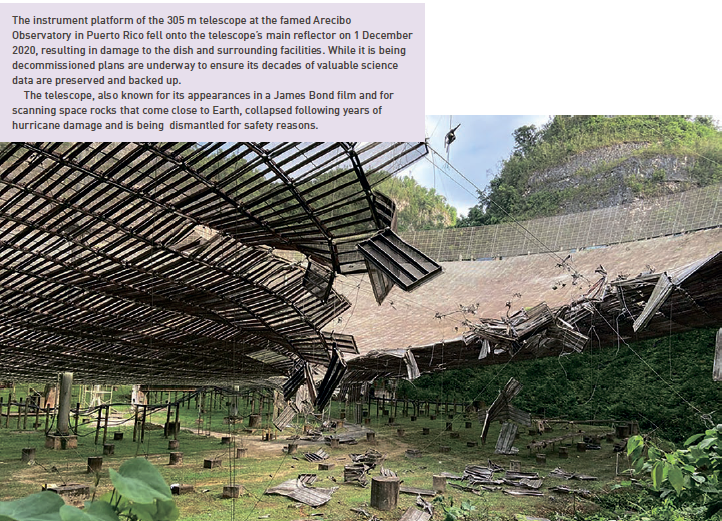
New century
In 2001, the Arecibo telescope celebrated the new century by gaining recognition as an IEEE Electrical Engineering Milestone and an ISME Mechanical Engineering Landmark.
Continuing the great discoveries, in 2003, the planetary radar system found evidence of hydrocarbon lakes on Saturn’s moon Titan. And a few years later, complex organic molecules were discovered in Arp 220, the first Megamaser galaxy found by Arecibo in 1982. These molecules are the fundamental building blocks with relevance to the origins of life in the universe. The first triple asteroid system, 2001 SN263, was discovered in 2008.
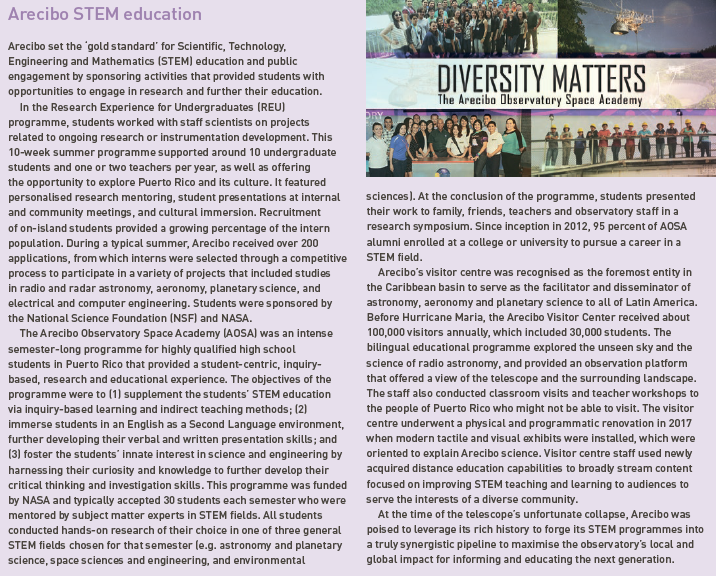
In 2012, Arecibo participated in a very long baseline (VLBI) experiment with the Russian RadioAstron, a 10-metre radio telescope launched by the Russian space agency into a highly elliptical Earth orbit. This collaboration formed the largest telescope ever, with a baseline 20 times the size of Earth! One important result of the joint Arecibo-RadioAstron work was the observation that the temperature of quasar 3C 273 is so high that it forces astronomers to reconsider the synchrotron emission mechanism invoked decades ago to account for these strong radio signals.
Arecibo also discovered two pulsars that undergo a ‘cosmic vanishing act’, sometimes ‘on’ and then ‘gone’ for very long periods
Arecibo then joined a multi-year VLBI campaign to measure the distance to the Pleiades star cluster and resolve the controversy created by measurements from the Hipparcos satellite, which was operational from 1989 to 1993. These observations used Arecibo’s large collecting area to chart the motions of ultra-weak radio stars and derive a new, independent distance. Results of unprecedented accuracy supporting the ground-based measurements were announced in 2014.
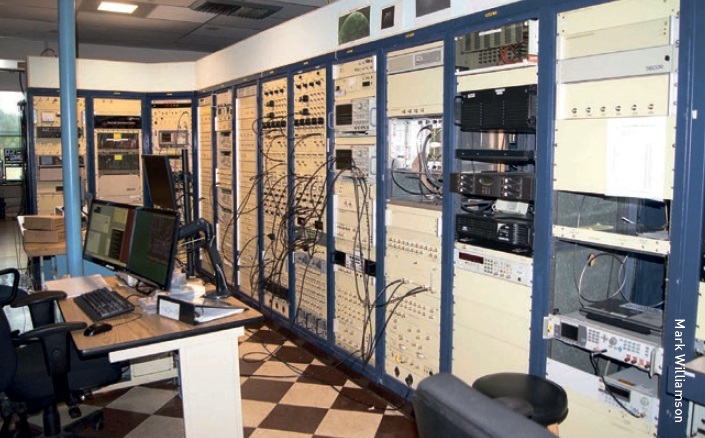 Arecibo telescope control room.
Arecibo telescope control room.
The same year, Arecibo discovered the second ever equal-mass binary Near-Earth Asteroid (NEA), 1994 CJ1 - the first, (68230) Hermes, having been discovered by Arecibo in 2003. Arecibo Radar went on to have a record-setting year in 2015, detecting 95 NEAs, 35 of which were potentially hazardous, and 23 were of interest for future robotic or crewed space missions.
Also in 2014, Arecibo detected a second pulse from a Fast Radio Burst (FRB), which made history as the first observation of a repeating FRB. FRBs are astronomical, millisecond-duration radio pulses that appear to be extragalactic, but have an unknown astrophysical origin. A repeating FRB demonstrates unequivocally that its source survives the energetic events that cause the bursts and rules out an entire class of models requiring catastrophic explosions. In concert with other telescopes around the world, Arecibo located the source of the signal, in 2016, in a dwarf galaxy three billion light-years distant.
Building on its earlier work with gravitational waves, Arecibo supported the work of NANOGrav, the North American Nanohertz Observatory for Gravitational Waves, which uses an array of high-precision millisecond pulsars to look for variations in the pulse arrival times as a function of angle and measure the strain produced as space-time warps. Data from Arecibo released in 2015 served to place constraints on the gravitational wave strain amplitude as the NANOGrav team continued its quest to discover gravitational waves from supermassive black hole binaries.
 The road below the telescope’s main reflector dish.
The road below the telescope’s main reflector dish.
Recent findings
Ground-breaking scientific discoveries are made possible by providing unique observing capabilities, state-of-the-art instrumentation and logistical support
Recent astronomical findings from Arecibo are impressive in their variety and importance. In yet another seminal study, an Arecibo survey of interstellar hydrogen, known by its acronym GALFA-HI, has revealed that the neutral gas is closely coupled to magnetic fields. This seemingly unlikely situation could be explained by a population of cold galactic electrons, which may even affect our ability to interpret the cosmic microwave background.
Arecibo also discovered two pulsars that undergo a ‘cosmic vanishing act’, sometimes ‘on’ and then ‘gone’ for very long periods of time. The discovery implies that there are an extremely large number of these vanishing-act pulsars, which may far outnumber regular pulsars. Although the explanation of the On-Gone behaviour remains a puzzle, they may redefine what we think of as ‘normal’ for a pulsar.
Moreover, Arecibo observations have set the standard for determining whether the most fundamental constant in physics, the fine structure constant, really is a constant. This constant describes the electromagnetic interaction between elementary charged particles and its value is crucial to understanding the nature of atomic spectra, which in turn allows astronomers to measure the radial velocity of galaxies from which these spectral lines are observed. Observations have led to the discovery that galaxies appear to be receding from one another with velocities that increase with the distance between them and this is a manifestation of the expansion of the universe following the Big Bang. Observations of the Hydroxide molecules in a cloud surrounding a distant quasar show that the fine structure constant has not changed by more than 1.3 parts in a million in three billion years.
As for Arecibo planetary radar observations of near-Earth asteroids, data from as far back as 1999 provided vital information on the orbit and physical properties of the NEA called Bennu. These results helped NASA select Bennu as the target for the OSIRIS-REx mission, which landed on Bennu in 2018 and will return an asteroid sample to Earth in 2023.
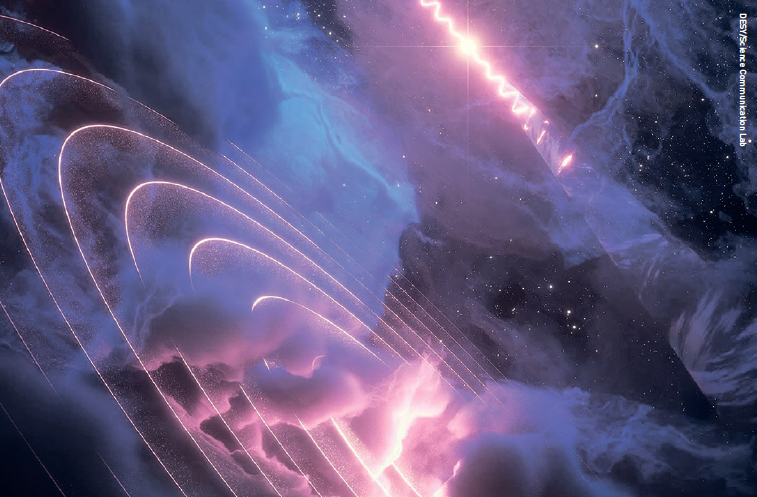 In 2020, an international team of researchers using data from Arecibo Observatory and the Fermi Space Telescope announced in the journal Nature Astronomy the discovery of what they called a “gamma-ray heartbeat” coming from a cosmic gas cloud. The cloud is in the constellation Aquilla and “beats” in rhythm with a black hole 100 light years away in a microquasar system known as SS 433.
In 2020, an international team of researchers using data from Arecibo Observatory and the Fermi Space Telescope announced in the journal Nature Astronomy the discovery of what they called a “gamma-ray heartbeat” coming from a cosmic gas cloud. The cloud is in the constellation Aquilla and “beats” in rhythm with a black hole 100 light years away in a microquasar system known as SS 433.
Shattered dreams
Even as we mourn the loss of this engineering wonder of the world, we celebrate Arecibo’s amazing scientific legacy
In general, ground-breaking scientific discoveries are made possible by providing unique observing capabilities, state-of-the-art instrumentation and logistical support. Arecibo’s strategic vision for the future sought to create an environment where discoveries like these continued and cutting-edge science was almost guaranteed with the anticipated installation of the Advanced L-band Phased Array Camera for Arecibo (ALPACA), a next-generation, cryogenically-cooled survey instrument. Meanwhile, anticipated upgrades to the planetary radar transmitter and data taking systems were expected to increase the annual detection rate of NEAs from 100 to 150 and play an increasingly vital role in planetary defence. However, these dreams of future science ended on 1 December 2020, when the Gregorian reflector platform of this iconic radio telescope fell to earth.
But even as we mourn the loss of this engineering wonder of the world, we celebrate Arecibo’s amazing scientific legacy. Its unique place in the history of science as the world’s largest radio telescope and the most powerful planetary radar has led to hundreds of discoveries relating to pulsars, galaxies, asteroids, comets, planets, exoplanets, and so much more.
About the author
Dr Joan Schmelz is Director of the NASA Postdoctoral Program at the Universities Space Research Association (USRA) and her research involves observations of solar coronal loops and developing constraints for coronal heating models. She was the deputy director of the Arecibo Observatory (2015-18) and the Associate Director for Science & Public Outreach at SOFIA (2018-19). She was a programme officer for the National Science Foundation’s Division of Astronomical Sciences (2013-15) and a professor at the University of Memphis for over 20 years. Schmelz is also Senior Vice President of the American Astronomical Society and former chair of the Committee on the Status of Women in Astronomy; she lectures and writes on topics such as unconscious bias, stereotype threat and the gender gap. She was honoured in 2015 as one of Nature’s top ten people who made a difference in science for her work fighting sexual harassment.





